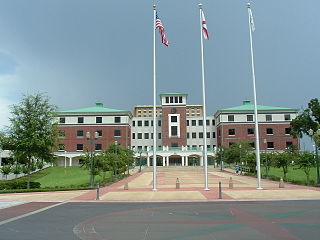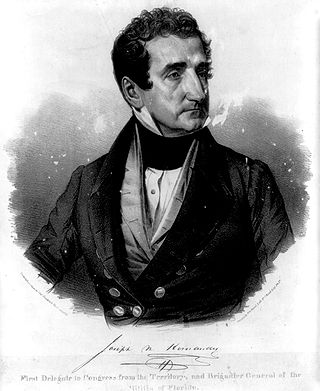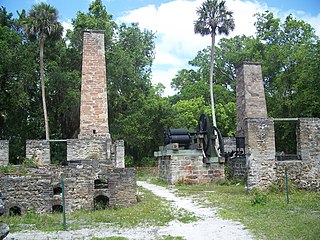
Indian River County is a county located in the southeastern and east-central portions of the U.S. state of Florida. As of the 2020 census, the population was 159,788. Its seat is Vero Beach. It is Florida's 7th richest county and in 2000 was the 87th richest county in the U.S. by per capita income.

Osceola County is a county located in the central portion of the U.S. state of Florida. As of the 2020 census, the population was 388,656. Its county seat is Kissimmee. Osceola County is included in the Orlando–Kissimmee–Sanford, Fla. Metropolitan Statistical Area.

St. Lucie County is located in the southeastern portion of the U.S. state of Florida. As of the 2020 census, the population was 329,226. The county's seat is Fort Pierce, while the largest city is Port St. Lucie, making up 62% of the county's population. St. Lucie County is the principal county of the Port St. Lucie, FL Metropolitan Statistical Area.

Seminole County is a county located in the central portion of the U.S. state of Florida. As of the 2020 census, the population was 470,856, making it the 13th-most populated county in Florida. Its county seat and largest city is Sanford. Seminole County is part of the Orlando-Kissimmee-Sanford, Florida Metropolitan Statistical Area.

Volusia County is located in the east-central part of the U.S. state of Florida between the St. Johns River and the Atlantic Ocean. As of the 2020 census, the county was home to 553,543 people, an increase of 11.9% from the 2010 census. It was founded on December 29, 1854, from part of Orange County, and was named for the community of Volusia, located in northwestern Volusia County. Its first county seat was Enterprise. Since 1887, its county seat has been DeLand.

Hobe Sound is an unincorporated area and census-designated place (CDP) in Martin County, Florida, United States, located along Florida's Treasure Coast. The population was 13,163 at the 2020 census, up from 11,521 in 2010.

Brighton Seminole Indian Reservation is an Indian reservation of the Seminole Tribe of Florida, located in northeast Glades County near the northwest shore of Lake Okeechobee. It is one of six reservations held in trust by the federal government for this tribe. The reservation has a land area of approximately 146 square kilometers or 36,000 acres and a 2000 census resident population of 566 persons.

Area codes 407 and 689 are telephone area codes in the North American Numbering Plan (NANP) for the city of Orlando and surrounding areas in the U.S. state of Florida. The numbering plan area (NPA) includes Orange, Osceola and Seminole counties, as well as small portions of Volusia and Lake counties.

Joseph Marion Hernández was a slave-owning American planter, politician and military officer. He was the first delegate from the Florida Territory and the first Hispanic American to serve in the United States Congress. A member of the Democratic-Republican Party, he served from September 1822 to March 1823.

The Canaveral National Seashore (CANA) is a National Seashore located between New Smyrna Beach and Titusville, Florida, in Volusia and Brevard Counties. The park, located on a barrier island, was created on January 3, 1975, by an act of Congress. The park is split between Brevard and Volusia counties, with 9 miles of the seashore in Brevard County, and 15 miles of the seashore in Volusia County. CANA consists of 24 miles of beaches, dunes, mangrove wetlands, and a large portion of the Mosquito Lagoon. The Canaveral National Seashore is also the longest expanse of undeveloped land along the East Coast of Florida. The Canaveral National Seashore is home to more than 1,000 plant species and 310 bird species. CANA occupies 57,662 acres (23,335 ha). There are 3 major beach sections in the seashore. The southern section is Playalinda Beach, the middle section is Klondike Beach, and the northern section is Apollo Beach.

Enterprise is an unincorporated community in Volusia County, in the U.S. state of Florida, and its former county seat. Situated on the northern shore of Lake Monroe, it is flanked by the cities of DeBary and Deltona. Enterprise was once the head of navigation on the St. Johns River and at various times, the county seat for three different counties: Mosquito, which was renamed as Orange; and lastly, for Volusia, which was formed from part of Orange County.

The Dunlawton Plantation and Sugar Mill, a 19th-century cane sugar plantation in north-central Florida, was destroyed by the Seminoles at the beginning of the Second Seminole War. The ruins are located at 950 Old Sugar Mill Road, Port Orange, Florida. On August 28, 1973, the site was added to the United States National Register of Historic Places under the title of Dunlawton Plantation-Sugar Mill Ruins.

The Episcopal Diocese of Central Florida is a diocese in Florida in Province IV of the Episcopal Church. It is bounded on the north by the Episcopal Diocese of Florida, on the east by the Atlantic Ocean, on the south by the dioceses of Southeast Florida and Southwest Florida and on the west by the Gulf of Mexico. The two largest cities in the diocese are Orlando, with over 220,000 people, and Port St. Lucie, with over 150,000 people. The Kennedy Space Center and Walt Disney World are located within the diocese. Orlando, where St. Luke's Cathedral is located, is the see city of the diocese.

Douglas Dummett (1806–1873) was an American planter, plantation owner, and politician. He served as a member of the Legislative Council of the Territory of Florida representing St. Johns County in 1843, and a member of the Florida House of Representatives representing Mosquito County in 1845. He was instrumental in developing the Indian River Citrus industry in Florida.

This is a timeline of the U.S. state of Florida.
The History of Brevard County can be traced to the prehistory of native cultures living in the area from pre-Columbian times to the present age. Brevard County is a county in the U.S. state of Florida, along the coast of the Atlantic Ocean. The geographic boundaries of the county have changed significantly since its founding. The county is named for Judge Theodore W. Brevard, an early settler, and state comptroller, and was originally named St. Lucie County until 1855. The official county seat has been located in Titusville since 1894, although most of the county's administration is performed from Viera.
William F. Russell was an American politician. He was a settler in Florida, soldier, and member of the Florida House of Representatives, serving as Speaker of the House in 1854. Russell was born in North Carolina. He became a major, and was put in charge of the Indian River Settlement in St. Lucia County, which broke up following an attack by Seminole Indians in July 1849. Russell was shot in the arm during the attack. Russell's brother-in-law John Barker was killed. The rest of his family escaped to New Smyrna.
The Hernández–Capron Trail also known as the Hernández Trail is a historic trail in Eastern Florida extending between New Smyrna in Volusia County and Fort Pierce in St. Lucie County. It was the first road from St. Augustine to the Fort Pierce area. It was originally cut through the Atlantic Coastal Ridge by Joseph Marion Hernández. The majority of the trail is in wilderness, although some portions traverse developed areas.















